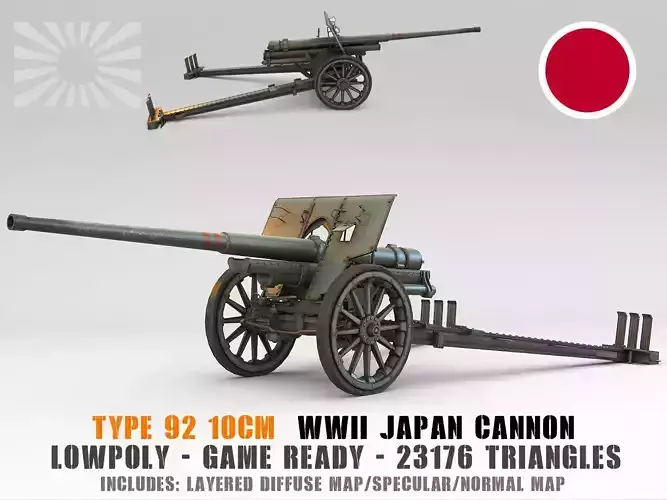1/13
Lowpoly Model of WW2 Type 92 10 cm Japan cannon
Model contains real details and proportions. Textures: 2048x2048 Color map (psd) - AO on layer - - color map Normal map 2048x2048, Specular map 2048x2048, Wheels textures 1024x1024 (Color, Normal.Specular) (Color, Normal, Specular).
Separate textures for cannon and wheel.
Texture designed for scaling - great for mobile games. Textures can be used in unlit mode
"The Type 92 10 cm cannon was developed from 1923–1924, as a long range alternative to the Imperial Japanese Army's existing 75 mm field artillery. Production was delayed due to technical issues, notably a desire by the army to reduce the weight of the weapon to a minimal level, and additional requirements issued by the army in 1927 to increase the range of the yet-to-be-completed weapon to 17,500 metres (19,100 yd). A suitable prototype was finally completed in 1932, and, after extensive testing, went into production and combat service in 1934. A total of 180 units were produced.[6]
This piece appears to have almost completely replaced the Type 14 10 cm cannon. It has all the standard features of the 1930–1936 period of Japanese gun design. In traveling position the tube is retracted by means of a winch and locked to the cradle. The most remarkable fact about the Type 92, aside from its appearance, is the great range that it attains with a 35-pound shell in proportion to its unusually low weight. It has been reported that the weapon is rarely fired at extreme ranges, which require the use of a supercharge, because of malfunctions in the recoil system caused thereby. Some years ago troubles with the recoil system were so frequent that extra glands and packing for the recoil cylinders were carried in the firing battery, and replacing them was equivalent to first-echelon maintenance in U.S. practice. Difficulties were also reported when the weapon was fired at or near the limits of traverse. Whether this was due to a unique bug in the design of the Type 92 or was inherent in the use of spade-plate stabilization is not known. The Type 92 is stabilized by three spade plates for each trail. Both spade plates and trail blocks are demountable."
REVIEWS & COMMENTS
accuracy, and usability.













